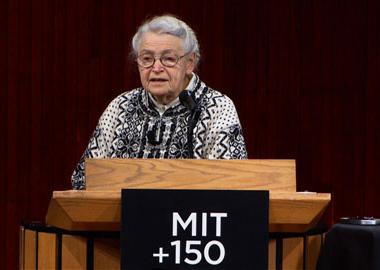 With many years of academic and corporate workplace experience among them, these panelists share expertise and best practices for recruiting and retaining women to science and engineering careers.
With many years of academic and corporate workplace experience among them, these panelists share expertise and best practices for recruiting and retaining women to science and engineering careers.Mildred Dresselhaus came to MIT to teach physics to engineering students. Although she received a scholarship funding women in science, she always believed “it was important for men to take you seriously, and not to worry about your sex.” Dresselhaus feels she “works for her students, and they work for her,” and says she learned a lot about teaching and providing for students’ careers from her years as a mother to four children. She believes mentoring serves an important function on campus, for men and women, and that it can prove particularly helpful to women, who may lack self-confidence. Her mentoring, which includes weekly meetings with some young women faculty, emphasizes some basic ideas, such as curiosity, creativity, being skeptical and thinking innovatively. She also wants her protégées to learn how to “handle disappointment,” since work “at the cutting edge doesn’t work most of the time.” She is particularly sympathetic to the challenges of combining work and family life, which still
falls most heavily on women, and the continuing requirement that women demand equal treatment “and stick up for themselves.”
Women leave their university positions, says
Lotte Bailyn, for two primary reasons: their sense of a hostile climate, such as lack of department head support, leading to loss of confidence and productivity; and the difficulties of managing child care, elder care and dual careers. Universities can achieve greater success with retention by systematically undertaking climate surveys that demand administrative follow-up; sensitizing faculty and administrators to gender bias; including women proportionately in committee work and decision-making; and offering family policies, including help with dual career couples. Bailyn hopes that universities will come to collaborate and coordinate on issues of retention, perhaps with recruitment consortia.
Cherry Murray brings decades of experience at one of the nation’s premier research labs to her administrative position at Harvard. She derides the “Darwinian leadership model” that holds sway in academia, which “leaves academic scientists and engineers to their own devices to kind of stumble into management and leadership positions. Murray sees this as “wrongheaded,” and that leadership is a learned trait, which can be fostered by “actually training people.” She recommends the kind of leadership development employed by Bell Labs, where managers select “a few stars” to develop as leaders for top positions; mentoring these individuals and middle-level managers; offering challenging assignments internally, and educational opportunities externally; regular, constructive reviews; networking opportunities with others at the same level; and succession planning exercises. Sensitivity training to offset potential “undervaluing of women or minorities” is extremely important, says Murray, and “the upper level management is completely key.” She believes this model could and should “be morphed and used effectively in academia.”...Read the full article/Watch Video
Women leave their university positions, says
Lotte Bailyn, for two primary reasons: their sense of a hostile climate, such as lack of department head support, leading to loss of confidence and productivity; and the difficulties of managing child care, elder care and dual careers. Universities can achieve greater success with retention by systematically undertaking climate surveys that demand administrative follow-up; sensitizing faculty and administrators to gender bias; including women proportionately in committee work and decision-making; and offering family policies, including help with dual career couples. Bailyn hopes that universities will come to collaborate and coordinate on issues of retention, perhaps with recruitment consortia.
Cherry Murray brings decades of experience at one of the nation’s premier research labs to her administrative position at Harvard. She derides the “Darwinian leadership model” that holds sway in academia, which “leaves academic scientists and engineers to their own devices to kind of stumble into management and leadership positions. Murray sees this as “wrongheaded,” and that leadership is a learned trait, which can be fostered by “actually training people.” She recommends the kind of leadership development employed by Bell Labs, where managers select “a few stars” to develop as leaders for top positions; mentoring these individuals and middle-level managers; offering challenging assignments internally, and educational opportunities externally; regular, constructive reviews; networking opportunities with others at the same level; and succession planning exercises. Sensitivity training to offset potential “undervaluing of women or minorities” is extremely important, says Murray, and “the upper level management is completely key.” She believes this model could and should “be morphed and used effectively in academia.”...Read the full article/Watch Video
For more techical information visit our sister website www.engineeringmaintenance.info or for equipment procurement please visit www.engineeringtrader.com

